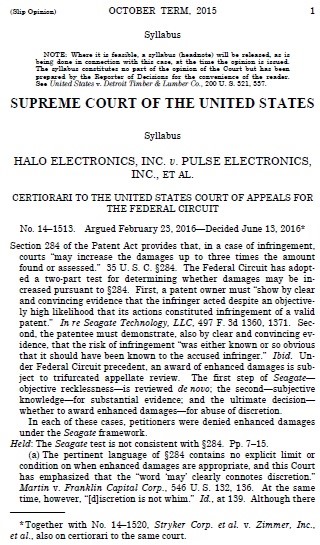【智財評析】故意侵權懲罰性賠償的認定標準放鬆:美國聯邦最高法院Halo v. Pulse案評析
2019-08-20 陳志清 律師/專利師

【重要美國專利案例評析】
美國聯邦最高法院於2016年6月15日由全體九位法官一致通過,關於美國專利法第284條的故意侵權懲罰性賠償-亦即「三倍賠償額」之規定,於Halo案中作出重要判決:(1) 推翻了聯邦巡迴上訴法院於2007年在Seagate案中所建立的「兩步測試法」,(2) 降低了原告所需負擔的舉證責任,並且(3) 改變了聯邦巡迴上訴法院的上訴審理範圍。因此,日後故意侵權懲罰性賠償的認定標準放鬆,非常值得大家注意!
案件背景事實
原告為Halo Electronics, Inc.(以下簡稱Halo),是電路板上的表面安裝元件(surface mount electronic packages)之供應商,被告為Pulse Electronics, Inc.以及Pulse Electronics, Corp.(以下合稱Pulse),是原告在亞洲的競爭對手。Pulse出貨的主要客戶之一,是美國公司Cisco位於亞洲的製造商。
本案中所涉及的商業交易模式其實很常見:Cisco會先跟其供應商Pulse簽訂一份主約,約定製造能量、保證最低價格、以及出貨前置時間等。待主約簽了之後,針對特定的元件,Cisco日後會再用訂單的方式來跟Pulse確定具體的價格跟出貨量,以便Pulse出貨給Cisco位於亞洲的製造商。Cisco位於亞洲的製造商則將Pulse的元件組裝成網路路由器,再出貨給Cisco。
2002年時,Halo發了兩封函給Pulse,詢問Pulse是否要取得Halo專利的專利授權。Pulse於收到信之後,找了一個工程師看了約兩小時,然後認定Halo的專利無效。就這樣,Pulse沒有尋求專家意見,也沒有律師意見,甚麼都沒有。後來Pulse的證人在法庭上作證時,也明白表示,他並沒有察覺到,公司內部有任何人有意識地做出了「可以繼續賣這些產品」的這個結論。
2007年,Halo受不了後就起訴Pulse專利侵權。聯邦地方法院的陪審團最後做出四點結論:(1) 就直接出貨到美國的產品,Pulse成立直接侵權;(2) 就出貨到海外,但最終以終端產品型態進口到美國給Cisco的產品,Pulse成立引誘侵權;(3) 「有很高的可能性」(highly probable)Pulse成立故意侵權;以及(4) Halo所主張的專利有效。
Pulse至此幾乎全敗,但是針對上面的結論第(3)點,聯邦地方法院的法官認為,依據聯邦巡迴上訴法院於2007年在Seagate案中所建立的「兩步測試法」,第一步的"objective reckless"對Pulse來說並不成立,因此並不會構成故意侵權。不成立的原因是法官認為,Pulse合理地倚賴其專利為顯而易見的防禦方法,即使這個防禦方法最後失敗了,由於其並非沒有客觀上的基礎,所以不能說Pulse是"objective reckless"。聯邦地方法院的這個見解,得到聯邦巡迴上訴法院的支持。
另一案,專利權人Stryker Corporation、Stryker Puerto Rico, Ltd.以及Stryker Sales Corporation(以下合稱Stryker),被控侵權人是Zimmer, Inc.以及Zimmer Surgical, Inc.(以下合稱Zimmer),二家公司於骨科脈衝清洗設備(orthopedic pulsed lavage devices)之市場上同為競爭廠商,2010年展開了專利侵權訴訟,於2015年聯邦地方法院的陪審團判決Zimmer故意侵害Stryker的專利,且判決給予「三倍賠償額」(treble damages)。然而,聯邦巡迴上訴法院雖然支持地方法院所做出專利侵害的判決,但卻廢棄給予三倍賠償額之決定,原因是其認為被控侵權人Zimmer已經有提出「合理的防禦」(reasonable defenses)之主張。
案件爭點
兩案件的主要案件爭點相同,皆為究竟聯邦巡迴上訴法院於2007年在Seagate案中所建立的「兩步測試法」是否符合美國專利法第284條的相關規定。因此,聯邦最高法院就此兩案件合併進行該法律爭點之審理。
以Halo案為例,這中間有個奇怪的地方,就是被控侵權人Pulse所主張的專利為顯而易見的此一防禦方法,其實是於被控告之後才提出來的,而非當初賣產品時就有這個信念。然而,專利權人所提出的這爭論點並沒有被聯邦巡迴上訴法院接受,因為上訴法院認為「行為人主觀的想法,在判斷”objective reckless”時是不重要的」。這一點其實就是本案聯邦最高法院覺得最有問題的地方,因此加以審理。
相關法律規定
1. 關於美國專利法第284條的故意侵權懲罰性賠償-亦即「三倍賠償額」之規定如下:
35 U.S.C. §284-Damages
Upon finding for the claimant the court shall award the claimant damages adequate to compensate for the infringement, but in no event less than a reasonable royalty for the use made of the invention by the infringer, together with interest and costs as fixed by the court.
When the damages are not found by a jury, the court shall assess them. In either event the court may increase the damages up to three times the amount found or assessed. Increased damages under this paragraph shall not apply to provisional rights under section 154(d).
The court may receive expert testimony as an aid to the determination of damages or of what royalty would be reasonable under the circumstances.
2. 聯邦巡迴上訴法院於2007年在Seagate案中所建立的「兩步測試法」(two-part test):
(1) 「兩步測試法」之兩步:
(i) 儘管客觀上其行為有很高的可能會構成有效專利的侵害,侵權者還是作了;以及
"the infringer acted despite an objectively high likelihood that its actions constituted infringement of a valid patent"
(ii) 這個客觀界定的風險已被被控侵權者所知悉,或是明顯到其應該知悉。
"this objectively-defined risk ... was either known or so obvious that it should have been known to the accused infringer"
以上兩步都必須成立,才會成立故意侵權。
(2) 原告所需負擔的舉證責任之標準:
(i) 於第一步”objective recklessness”時,原告需依據「證據明確」(clear and convincing evidence)之標準來進行舉證責任;
(ii) 於第二步”subjective knowledge”時,原告亦需依據「證據明確」之標準來進行舉證責任。
(3) 上訴法院的審理範圍:
Seagate案中關於上訴法院的審理範圍之架構設定的很複雜,為一個「三叉法庭」(trifurcation court)的上訴審理方式:
(i) 第一步”objective recklessness”是法律問題,上訴法院可「重新審理」(reviewed de novo);
(ii) 第二步”subjective knowledge”是事實問題,上訴法院則審理地方法院是否有依照「實質證據審查」(for substantial evidence)標準;
(iii) 至於最終問題,整體有無故意、是否給予懲罰性賠償也是事實問題,上訴法院只能審理地方法院是否有「裁量權之濫用」(for abuse of discretion)。
聯邦最高法院見解
聯邦最高法院同意審理此二案件之上訴案,最後推翻(vacated)了聯邦巡迴上訴法院之見解,並發回(remanded)重審。
在本案中,聯邦最高法院幾乎是把2014年所做出的Octane Fitness, LLC v. Icon Health & Fitness, Inc.案,以及Highmark Inc. v. Allcare Health Mgmt. Sys., Inc.案這兩個案子的論理架構(這兩個案子是關於美國專利法第285條,被告可以向原告請求律師費的相關規定)整個搬過來使用。對該兩個案件有印象及初步理解的話,看本案判決文就會很快。
(1) 聯邦巡迴上訴法院於2007年在Seagate案中所建立的「兩步測試法」被推翻:
首先,聯邦最高法院認為,Seagate案的「兩步測試法」最大的問題,是它要求被控侵權人一定要具有”objective recklessness”。但這阻卻了某些惡意的侵權人,為了奪取專利權人的生意,在不懷疑專利有效性、也沒有注意到任何防禦方法的情況之下侵權的裁量處罰:
The principal problem with Seagate’s two-part test is that it requires a finding of objective recklessness in every case before district courts may award enhanced damages. Such a threshold requirement excludes from discretionary punishment many of the most culpable offenders, such as the “wanton and malicious pirate” who intentionally infringes another’s patent—with no doubts about its validity or any notion of a defense—for no purpose other than to steal the patentee’s business.
Halo Electronics, Inc. v. Pulse Electronics, 136 S. Ct. at 1932 (2016)
這個問題在於,被控侵權人只要於訴訟時可提出防禦方法,就可以免於「懲罰性賠償」-即使於當時侵權時,侵權人並非基於、或甚至可能根本就沒有察覺到這個他後來才提出的防禦方法。一般而言,惡意是基於行為人行為時的認識來判斷的:
The Seagate test aggravates the problem by making dispositive the ability of the infringer to muster a reasonable (even though unsuccessful) defense at the infringement trial. The existence of such a defense insulates the infringer from enhanced damages, even if he did not act on the basis of the defense or was even aware of it. Under that standard, someone who plunders a patent—infringing it without any reason to suppose his conduct is arguably defensible—can nevertheless escape any comeuppance under §284 solely on the strength of his attorney’s ingenuity.
But culpability is generally measured against the knowledge of the actor at the time of the challenged conduct.
Halo Electronics, Inc. v. Pulse Electronics, 136 S. Ct. at 1933 (2016)
被控侵權人Pulse的狀況就是如此。Pulse對Halo專利無效的論點,是在訴訟中才提出的。於2002年收到Halo所發出的授權信函之後,其實他並沒有怎麼積極處理、也沒有真的產生專利無效的信念。然而,Pulse後來於訴訟中才提出的防禦方法,卻變成可以阻卻Pulse之前侵權行為時「客觀上」的高風險成立,這點現在並不被聯邦最高法院所接受。
討論到最後,聯邦最高法院的結論是,美國專利法第284條允許聯邦地方法院懲罰各種惡意的行為,法院應該考量各個案件中的獨特狀況來決定損害賠償,不受Seagate測試的限制。不過,經過約兩世紀發展,通常專利法的「懲罰性賠償」是保留給「典型的極其嚴重之惡意不正當行為」(egregious cases typified by willful misconduct):
Section 284 allows district courts to punish the full range of culpable behavior. Yet none of this is to say that enhanced damages must follow a finding of egregious misconduct. As with any exercise of discretion, courts should continue to take into account the particular circumstances of each case in deciding whether to award damages, and in what amount. Section 284 permits district courts to exercise their discretion in a manner free from the inelastic constraints of the Seagate test. Consistent with nearly two centuries of enhanced damages under patent law, however, such punishment should generally be reserved for egregious cases typified by willful misconduct.
Halo Electronics, Inc. v. Pulse Electronics, 136 S. Ct. at 1933-1934 (2016)
到這邊大家可以思考一下:聯邦最高法院的話,有講得很清楚嗎?個人是認為沒有。法院說的是:「看看兩百年來的發展,然後個案判斷吧。」這真的是很不明確啊,以後在聯邦地方法院打訴訟時,真的要找個能言善道的律師了~~!
(2) 將原告所需負擔的舉證責任之標準降低:
原先Seagate案關於”objective recklessness”的舉證標準,原本是為「證據明確」(clear and convincing)標準。現在聯邦最高法院則認為,專利侵權訴訟一直以來都是依照「證據優勢」(preponderance of evidence)標準來做判斷,於判斷是否給予「懲罰性賠償」時亦沒有例外:
As we explained in Octane Fitness, “patent-infringement litigation has always been governed by a preponderance of the evidence standard.” 572 U. S., at ___, 134 S.Ct., at 1758. Enhanced damages are no exception.
Halo Electronics, Inc. v. Pulse Electronics, 136 S. Ct. at 1934 (2016)
(3) 上訴法院的審理範圍改變:
原先Seagate案中關於上訴法院的審理範圍之架構設定的很複雜,為一個「三叉法庭」的上訴審理方式,已如前所述,真的是搞得非常複雜。現在聯邦最高法院則說:關於是否給予「懲罰性賠償」,上訴法院只能審理地方法院是否有「裁量權之濫用」:
Section 284 gives district courts discretion in meting out enhanced damages. It “commits the determination” whether enhanced damages are appropriate “to the discretion of the district court” and “that decision is to be reviewed on appeal for abuse of discretion.” Highmark, 572 U.S., at ___, 134 S. Ct., at 1748.
Halo Electronics, Inc. v. Pulse Electronics, 136 S. Ct. at 1934 (2016)
小結
1. 由於Seagate「兩步測試法」已經被推翻,且降低了原告所需負擔的舉證責任之標準,而上訴法院審理範圍的空間也變小,所以就這個Halo案整體而言,放鬆了故意侵權「懲罰性賠償」的認定標準,而且大部分都交由聯邦地方法院來做個案裁量,也就是說不確定性相對地提高。
2. 關於本案發回後,究竟聯邦地方法院後續是如何地採用該聯邦最高法院所闡釋的標準來進行判斷,以及本案於發回後聯邦地方法院的判決結果為何,也是頗值得關注的地方。
本文章之專業內容,僅為提供資訊參考,非作為法律諮詢之用,亦純屬作者個人之意見,不代表本所或作者任何曾任職過單位之立場。
相關參考資料
1. 聯邦最高法院判決:Halo Electronics, Inc. v. Pulse Electronics, Inc. (Supreme Court, June 13, 2016) 案判決原文(網址:https://www.supremecourt.gov/opinions/15pdf/14-1513_db8e.pdf)(最後瀏覽日期:2019年6月27日)。
2. 專利權人的移審請求:Petition for a writ of certiorari (June 22, 2015) (Represented by Fish and Richardson) 原文內容(網址:https://www.scotusblog.com/wp-content/uploads/2015/10/Halo-cert-petition-final6.pdf)(最後瀏覽日期:2019年6月27日)。
3. 聯邦巡迴上訴法院判決:Halo Electronics, Inc. v. Pulse Electronics, Inc., 769 F.3d 1371 (Fed. Cir., October 22, 2014) 案判決原文(網址:https://scholar.google.com/scholar_case?q=halo+pulse&hl=en&as_sdt=4,131&case=16234378933529520041&scilh=0);以及Stryker Corp. v. Zimmer, Inc., 782 F.3d 649 (Fed. Cir., March 23, 2015) 案判決原文(網址:https://scholar.google.com/scholar_case?q=2013-1668&hl=en&as_sdt=4,131&case=5069061918065561144&scilh=0)(最後瀏覽日期:2019年6月27日)。
延伸閱讀:
-
2019-07-18
-
2019-07-18
消息來源:


